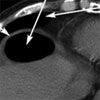Chilaiditi Syndrome
Dull, intermittent, midepigastric abdominal pain of 1 day's duration prompted a 73-year-old man to seek medical attention. He had no other symptoms.

Click to Enlarge

Click to Enlarge
Dull, intermittent, midepigastric abdominal pain of 1 day's duration prompted a 73-year-old man to seek medical attention. He had no other symptoms.
The abdomen was soft and minimally distended, with midepigastric tenderness and tympany. Bowel sounds were hypoactive; there were no peritoneal signs. An upright anteroposterior chest film revealed an elevated right hemidiaphragm with interposition of the transverse colon between the liver and diaphragm (A). A CT scan of the abdomen confirmed that the transverse and ascending colon were interposed anterior and superior to the liver (B). This rare presentation is known as Chilaiditi syndrome and mimics pneumoperitoneum.
Hepatodiaphragmatic interposition of the colon is known as the Chilaiditi sign.1 The prevalence of this anomaly is about 0.025% to 0.28%; it is thought to be more common in men.2 When associated with symptoms, such as pain, nausea, vomiting, abdominal distention, and constipation, the anomaly is called Chilaiditi syndrome.3 The syndrome is thought to be caused by congenital abnormalities of the diaphragm. It may also occur secondary to cirrhosis or chronic lung disease. Review of the literature shows a possible association between Chilaiditi syndrome and volvulus of the transverse colon.4,5 Indeed, in this patient, endoscopic decompression of the colon revealed a partial twisting of the transverse colon, suggestive of a volvulus. His symptoms resolved after the endoscopic procedure.
References:
REFERENCES:
1.
Chilaiditi D. Zur Frage der Hapatoptose und Ptose in allgemeinen im Auschluss an drei FÅ lle von temporÅ rer partieller Leberverlagerung. Fortschritte auf dem Gebiete der Roentgenstrahlen. 1910;11:173-208.
2.
Orangio GR, Fazio VW, Winkelman E, McGonagle BA. The Chilaiditi syndrome and associated volvulus of the transverse colon. An indication for surgical therapy. Dis Colon Rectum. 1986;29:653-656.
3.
Saber AA, Boros MJ. Chilaiditi's syndrome: what should every surgeon know? Am Surg. 2005;71:261-263.
4.
Matsushima K, Suzuki Y. Transverse colon volvulus and associated Chilaiditi's syndrome. Am J Surg. 2006;192:203-204.
5.
Plorde JJ, Raker EJ. Transverse colon volvulus and associated Chilaiditi's syndrome: case report and literature review. Am J Gastroenterol. 1996;91:2613-2616.